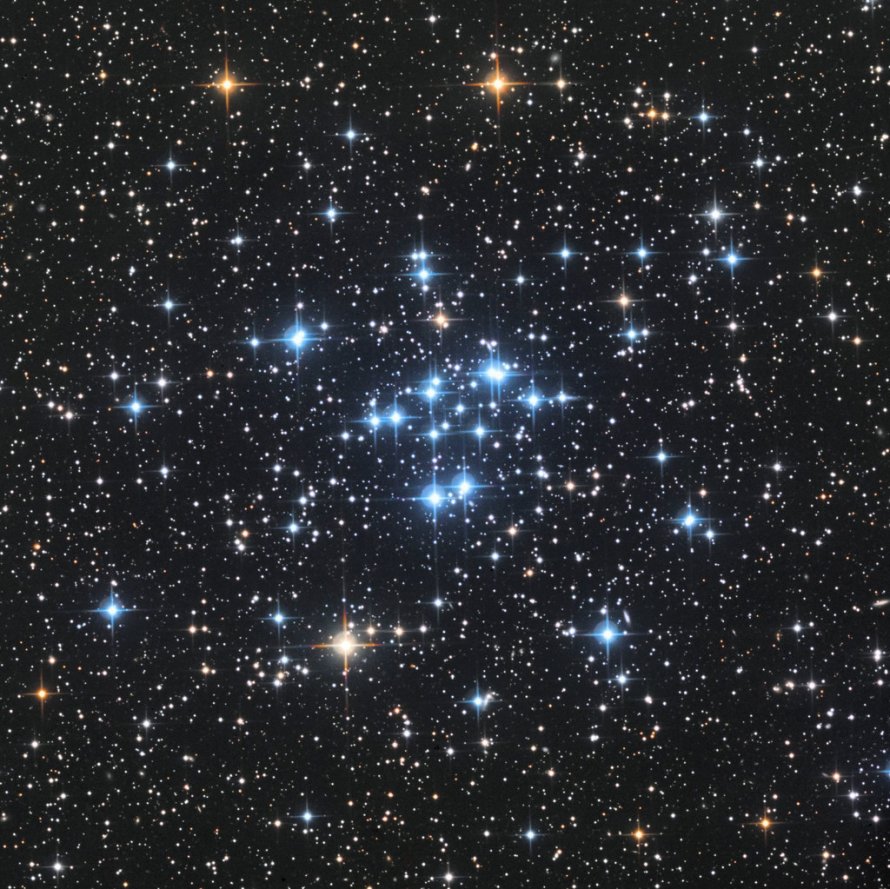M34 (NGC 1039)
Messier 34 (NGC 1039) is an open cluster located in the constellation Perseus, in the Orion Arm of the Milky Way Galaxy in the Local Group of galaxies. M34 is 1500 light years away from Earth.
M34 is best viewed during winter, is magnitude 5.5, and can be viewed with naked eye (barely). M34 is 35' in apparent size. For reference, the full moon is 30'.
Observing difficulty: Easy
- Name:
- Type:
- open cluster
- Constellation:
- Perseus
- NGC or IC:
- NGC 1039
- Magnitude:
- 5.5
- Viewing:
- naked eye (barely)
- Size:
- 35'
- Distance (light years):
- 1500 LY
- RA:
- 2h 42.0m
- Dec:
- 42 47'
- Season:
- winter
- Milky Way location:
- Orion Arm
- Galaxy group:
- Local Group
- Messier Marathon #:
- 10
* The naked eye can see up to magnitude ~7-8 objects under ideal dark sky conditions.
An Open Cluster in Perseus
Scattered throughout our Milky Way Galaxy are various star clusters, each with its unique qualities and mysteries. One such cluster is Messier 34, an open star cluster located in the constellation of Perseus. This article explores the rich history, characteristics, and viewing conditions of M34, one of the many celestial wonders in the Messier Catalog.
Discovery and Observation History
The French astronomer Giovanni Batista Hodierna first discovered M34, probably before 1654. However, the cluster's recognition is most commonly attributed to Charles Messier, who included it in his catalog in 1764. In the centuries since, M34 has been a frequent target of astronomical study, with modern studies revealing valuable information about its member stars and overall structure.
Physical Characteristics and Magnitude
Messier 34 is an open cluster composed of several hundred stars, roughly 1,500 light-years away from Earth. It spans about 15 light-years in diameter, a relatively compact size considering the average distances between its stars are only a few light-years. Its member stars are relatively young, at approximately 200 million years old, and have similar compositions and velocities, indicating they formed together from the same molecular cloud. M34 has an apparent magnitude of 5.5, making it visible to the naked eye under ideal observing conditions.
Astronomical Significance
Open clusters like M34 provide astronomers with valuable opportunities to study stellar evolution. Because all the stars in an open cluster form at roughly the same time from the same cloud, differences in their current states are primarily due to their initial masses. Observations of M34 and other similar clusters have helped astronomers to refine models of how stars evolve over time, illuminating the life cycles of the very objects that make up our Universe.
Finding and Viewing M34
To locate M34, one needs to find the constellation Perseus in the night sky. The cluster lies approximately midway between the stars Algol (Beta Persei) and Almach (Gamma Andromedae). It is best viewed during the fall and winter months, when Perseus is high in the sky for northern hemisphere observers. Given its magnitude of 5.5, it is just visible to the naked eye in dark sky locations, but the use of binoculars or a small telescope will greatly enhance the view, resolving the cluster into its individual stars. Larger telescopes under dark skies will provide the most spectacular views, revealing the rich array of stars that make up this cluster.



